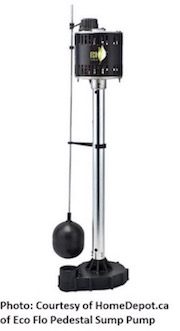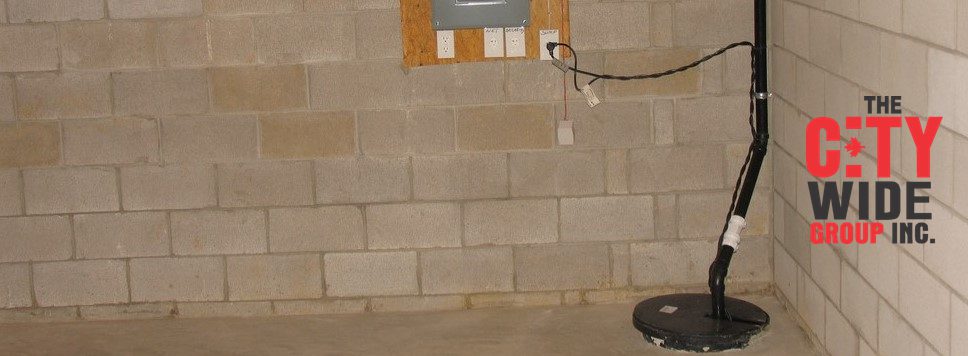A basement flood results in more than lost valuables. It leaves lasting damage in the walls that give way to the growth of mould and mildew, which are hazardous to your health. This is a result of the moisture left behind by a flood and will require renovation of the walls and floor. However, a basement flood doesn’t have to be an eventuality if you install a sump pump.
A sump pump is essentially a pit or hollow in the ground that pools excess water from the outside that is then pumped away from the home. Floods are caused by groundwater from the outside constantly posing a threat to your foundation wall, which may already have cracks. The more water that accumulates around the home as a result of a heavy downpour will increase the likelihood of a flood. With a sump pump, the device automatically turns on when water reaches a certain level in the pit.
Sump Pump: Essential for Basement Waterproofing in Toronto
Even regions with a dry climate require a sump pump because of compacted soil. When the area does have rainfall, the water expands the soil and puts pressure on the home’s foundation, causing cracks to form. The sump pump gives the surge of groundwater somewhere to go because a dry region will quickly flood, especially if it’s flat.

There is also an incentive to install a sump pump. The City of Toronto has introduced the Toronto Flood Subsidy Program in response to the increased frequency of severe storms in the GTA. Homeowners looking to install a sump pump should ask their contractor if they participate in the program, if so, they will provide you with a form to fill out that you will then need to send to the City. The contractor should be able to provide you with all the necessary information about the program and outline the reimbursable costs of the installation. You should act soon because it is not known how long the City of Toronto will provide the Flood Subsidy Program.
Types of Sump Pumps Used for Basement Waterproofing in Toronto
There are two distinct types of sump pumps. One is the submersible sump pump, which involves the whole machine lowered sitting in the pit and out of view. The other is the pedestal sump pump, which has a motor sitting atop in a casing above the pit. The pedestal sump pump intakes water through a pipe with a flotation device and drainage pipe connected to the pit.
Submersible Sump Pump
A submersible sump pump can either be in a stainless steel, cast iron or plastic casting. Since the pump is in the pit, it becomes fully submerged when water begins to flow in. This makes it quiet despite working similarly to a fan that provides the suction needed to send the water through the discharge pipe. This sump pump is also extremely durable because it can handle small particles of debris with zero damage.
The only downside is that the submersible sump pump is more expensive than the pedestal sump pump. This is due to the submersible having a standard motor of ½hp, which is quite powerful. This makes it ideal for homes in flood zones and on flat terrain while requiring little maintenance since the motor is kept cool under water.

Pedestal Sump Pump
The most significant benefit of a pedestal sump pump is that is can be easily replaced and requires little maintenance, however, it is far less power than the submersible – 1/3hp compared to the submersible’s high-powered 1/2hp. If you’re on a budget and your area receives little precipitation, then the pedestal is ideal.
This pump consists of a flotation device in a pit that raises and triggers the motor when the water reaches a certain level. The water is then pumped through a hose that’s attached to a discharge pipe. However, a huge drawback is that since it’s above the pit, it can easily overheat with no way to cool down if it’s running for an extended period. Also, the string that connects the flotation device to the pump can become clogged which can have a devastating effect on your home during a storm.
Sump Pump and Pit Installation
It is advised that you seek consultation from a licensed contractor before beginning the sump pump installation because some homeowners may need a new or expanded pit.
Digging/Expanding the Pit
Installation of a sump pit requires a concrete saw and a jackhammer to break through the floor. You will also need to determine the volume of water the pit should be able to handle. The average sump pit is usually 24” in diameter and can hold up to 14 gallons of water a minute.
Gravel is poured into the pit under the liner to collect dirt and debris to prevent disruptions in the sump pump. The sump pit is then lined with a plastic bin that looks similar to a garbage pail, with a hole cut in the side to connect the drainage pipes from the foundation to the sump pit.
Installing the Sump Pump
A sump pump requires a PVC pipe connected to the discharge connection to pump water out of the pit, along with the installation of a check valve. The valve is the most important component because it ensures the water pumped out of the pit only flows in one direction. The check valve must be installed and tested by a licensed contractor. PVC pipes and the check valve must be connected to the pump before the installation is completed to ensure everything fits properly. However, additional PVC pipes may be required to add height and may need to be replaced in the future. PVC pipes can either be cemented together or connected with clamps that allow for easy replacement of the valves and pipes if maintenance is required. Once the connections are sealed, the sump pump is lowered into the pit (if it’s a submersible pump).
A sump pump is just one component of keeping your basement dry. Exterior basement waterproofing is the only permanent protection against a flood, so give City Wide Group a call today at 416.283.5500 for a free quote!











